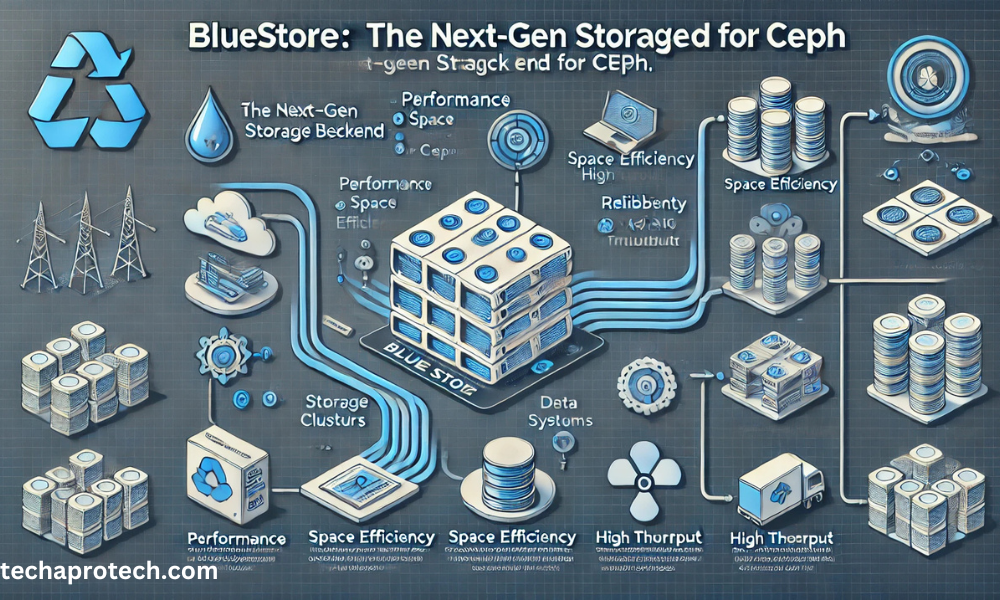BlueStore is a new storage back end technology introduced in Ceph, an open source, software defined storage system. Developed to solve performance, reliability, and efficiency issues, BlueStore is better supplied for data center applications. They also offers more precise storage for I/O bound applications. It require flexible and dependable storage platforms for cloud, distributed environments and high-end businesses.
Who and What are Ceph and BlueStore?
Ceph is a well-known distributed storage system that has multiple backends on how data will be handled, and BlueStore is Ceph’s newest one. Some of the new features include; BlueStore directly accesses storage devices unlike the predecessor FileStore which needed an external file system. First, this decision helps distil architecture and, second, it helps enhance I/O performance. It eliminates layers between the storage and the application.
The Architecture of BlueStore
BlueStore’s design is center around being directly on block devices. Here’s an overview of its architecture:
Raw Storage Devices: This store directly communicates with block devices, such as SSDs, without using the file system of an operating system. It is therefore possible to upgrade performance of the particular memory kind with direct connexon to another. This permits quicker directions for write and/or read procedures.
RocksDB: For managing metadata BlueStore uses RocksDB a high performance Database developed by Facebook company. Essentially, RocksDB is it’s internal metadata manager which holds mapping to objects and aids easy searching for the data.
Allocator System: It utilizes its allocator for storing the data blocks. It minimizes fragmentation and increases space used efficiently.
Journal and WAL (Write-Ahead Log): In this store, there is a journal, and Write-Ahead Log to maintain data integrity, and all the changes that occur are captured just in case of an instance where it can fail.
This structure frees it from a traditional filesystem dependency and optimizes all of its own data handling mechanisms with less latency.
Key Advantages
This store was designed to resolve many limitations encountered in earlier storage backends, delivering a range of advantages:
High Performance: Because of this, it dies not take up the overhead of a file system which in turn enhances the latency allowing Abiquo to act as high-performance storage. Data is taken directly from the disc and therefore, minimizes the number of functions required to store in I/O operational speeds.
Optimized Storage Utilization: Picking up from where we left off, this store’s allocator helps in avoiding fragmentation as well as in the proper utilization of space. This is even more useful for environments that are read and written heavily, to write and delete data at high speeds.
Enhanced Data Integrity: In the internal checksums, it cheques the integrity of the data, and the data remains fine since it has not been interfered with. It is an essential feature especially when operating an enterprise dealing in sensitive or important information.
Reduced Overheads with Direct Device Access: This store rids of layered systems making the effect on CPU and memory less and requiring a lower consumption of these system resources. Such a design results in efficiency in the use of resources to enhance the responsiveness of systems.
SSD-Optimized: Optimizing it is significantly effective when working with SSDs because their random read/write times are faster. This direct means of accessing block devices enable it to fully utilize SSD performance.
BlueStore vs. FileStore: A Comparative Look
Before BlueStore, FileStore was Ceph’s default backend, relying on traditional file systems such as XFS. Here’s how BlueStore stacks up against FileStore:
| Feature | BlueStore | FileStore |
| Storage Access | Direct access to block devices | Relies on file systems |
| Performance | High performance with low latency | Limited by file system I/O |
| Data Integrity | Built-in checksum verification | Limited data integrity |
| Efficiency | Optimized for SSDs, reduced overhead | Higher resource overheads |
| Compatibility | Suited for modern SSDs and HDDs | Primarily suited for HDDs |
All in all, BlueStore introduces more flexibility, improved performance as well as IOPS and reliability ofCeph backend storage system.”
Setting Up and Using BlueStore
As a result, for Ceph deployment to use BlueStore as its default storage backend, they can either configure it during the Ceph installation or switch from the FileStore. Here’s an overview of the setup:
Configure Ceph OSDs: Ceph’s building blocks are distributed objects called Object Storage Daemons (OSDs). To operate the BlueStore, you can set the software to be use during installation, or reformat the existing OSDs.
Set BlueStore as Default: By editing the Ceph configuration file, the administrator can set odd object store = bluestore, and make it the default backend.
Performance Tuning: BlueStore provides facets like number of RocksDB cache and wall settings can be tweaked. Even better results can be achieved if tuning is based on storage hardware since it implies the best practices.
Monitor Disk Health: Disc monitoring becomes easier because it came with its own checksums and tools with which the administrator can detect one or the other problems on the disc.
Use Cases for BlueStore
BlueStore is especially recommend for applications that work intensively with data and those that need low latency. Here are some of its common use cases:
Cloud Storage Providers: These are functional features and are exceedingly important for cloud providers who require a high performing storage system to provide their customers. In this case, data handling helps to minimize the costs of the provider. At the same time help in satisfying the clients.
Big Data and Analytics: The real-time analytics or the big data processing companies will indeed benefit from BlueStore. It could store volumes of data while not compromising with speed.
Machine Learning and AI Applications: Given the new functions introduced by AI and ML in organizations, the need for storage to handle high I/O operations arises. It can thus aid faster training and data analysis since it guarantees low latency access to the data.
Content Delivery Networks (CDNs): To the companies that transmit media content worldwide BlueStore provides fast data transfer to avoid buffer and accelerate access to multimedia content.
Financial Institutions: The feature that makes it suitable for use by finance organizations is stability. It guarantees data integrity and reliability.
Performance Tuning and Optimisation

While BlueStore is design to perform well out of the box, there are ways to further enhance its efficiency:
Adjust RocksDB Cache: The cache size for RocksDB can be increase BlueStore. It fragments data whereas metadata handling for large datasets can be improved.
Monitor Disk Latency: At one of the discs there is constantly low latency, therefore, do disc settings to keep the parameter at a high level. Up to the hardware profiles, running tuning in conjunction with BlueStore is possible.
Use SSDs: It has been specifically designed to operate with SSDs and performance is best when it is used. There is less fragmentation as well as the ability to swiftly access the discs.
Challenges and Limitations
Despite its advantages, it also has some challenges:
Complexity: However, for users who have previously used FileStore, BlueStore configuration appears to be quite complicated because of the new design.
Resource Requirements: Explaining the fact that BlueStore is a significantly more resource-hungry implementation than FileStore. Lannucci points out that RocksDB and direct device access consume more memory. It can burden the central processing unit.
Compatibility: The Ceph BlueStore is not forward-compatible with older systems or HDD-only configurations, as it is optimize for SSD.
Conclusion
BlueStore has emerged as the new storage technology within the realm of Ceph which provides optimal performance, low latency. It is secure enough to manage today’s challenging and dynamic data applications. This is design to the modern storage requirements and flexibility making it easy for organizations to deal with massive data. Despite the fact that it has its own set of challenges, it is hard to argue against choosing BlueStore for enterprises, cloud providers and content-oriented businesses who wants to achieve improved, reliable storage.

